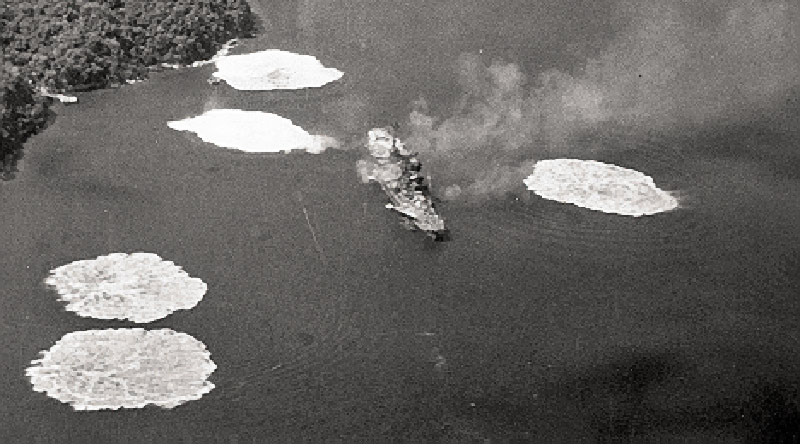|
A
R
T
I
C
L
E
S
|

H. PAUL
BREHM
WWII VETERAN INTERVIEW |
| |
Introduction
July 29, 1945,
on board USS Ticonderoga in the Pacific Ocean:
" TF38.3 TO
AG-87:.MESSAGE CONCERNING YESTERDAYS OPERSTIONS:,.THIS HAS BEEN A TOUGH DEY ,
FOR TASK GROUP YET,.THE RESULTS HAVE BEEN GOOD X ANUMBER OF ,.PILOTS HAVE BEEN
LOST ALTHOUGH MANY HAVE BEEN,.RECOVERED X ON THE GOOD SIDE PHOTOS SHOW THE
,.HYUGA THAT BASTARD BATTLESHIP IS ON THE BO-,.TTOM X THE CRUISER TONE MAY BE
AFLOAT BUT ,.SHE IS NO BARGAIN EVEN IN WOOLWORTHS BASEM-,.ENT , X THREE SUBS
MADE THEIR LAST DIVE FOR THE ,. JAPS THREE MERCHANT SHIPS WERE SUNK,.A
DESTROYER WAS LEFT SINKING AND 8 SHIPS ,.DAMAGED X ALOFT OUR PILOTS RAN INTO
,.HEAVY OPPOSITION AND SPLASHED 13 NIP FIGHTERS,.AT END OF DAY OUR CAP SPLASHED
A WANDER-,.ING JILL XM,. "
So announced the teletype on-board
the aircraft carrier USS Ticonderoga on July 29, 1945 after the bombing
of Kure and the last major fleet units of the Imperial Japanese Navy. During
those few days Task Force 38 – which included Ticonderoga –
bombed and sank the Japanese battleships Hyuga, Ise and
Haruna, the aircraft carrier Amagi, the heavy cruisers
Tone and Aoba and the scout cruiser Oyodo. Several older
training cruisers, submarines and destroyers were also sunk in these heavily
contested raids that not-so-quietly eliminated what remained of the Imperial
Navy, which until that point had remained a threat despite their inadequate
fuel supply. Other ships were also damaged in the raids, including Amagi's
sister carrier Katsuragi and the old carrier Hosho. This final
act of retribution for the Pearl Harbor attack is mostly forgotten today, but
the aircrews and sailors caught-up in this short but violent campaign witnessed
some of the last organized fighting to take place before atomic weapons and the
Soviet declaration of war spelled certain defeat to the Japanese
government.
The following conversations and accounts are courtesy of
Lieutenant Commander (R) H. Paul Brehm, an SB2C dive bomber pilot who took part
in the air attacks on Hyuga and Tone as a member of VB-87, which
operated from USS Ticonderoga. Because both Japanese warships received
 multiple
hits in rapid succession (the bombing interval between planes was five seconds)
no one person is credited with their sinkings. Then Lieutenant (jg) Brehm
however, did place one of his 1,000 pound bombs into the stern of the
Hyuga and another close alongside the Tone, winning a Navy Cross
for "...contributing materially to the sinking of the hostile vessel" in the
case of Hyuga. Even without these successes, his mere presence at the
scene made him a valuable eyewitness to these events and others which occurred
in 1945 and earlier in 1943 when he served in the Solomons campaign. multiple
hits in rapid succession (the bombing interval between planes was five seconds)
no one person is credited with their sinkings. Then Lieutenant (jg) Brehm
however, did place one of his 1,000 pound bombs into the stern of the
Hyuga and another close alongside the Tone, winning a Navy Cross
for "...contributing materially to the sinking of the hostile vessel" in the
case of Hyuga. Even without these successes, his mere presence at the
scene made him a valuable eyewitness to these events and others which occurred
in 1945 and earlier in 1943 when he served in the Solomons campaign.
The idea for this interview came one day when Paul and I were talking
about his search for Hyuga images and he mentioned the teletype.
"Teletype?" I asked. "Yeah." he replied, "I've still got it."
As it turned
out, he had kept the original paper tape that came off the teletype machine
on-board Ticonderoga at the conclusion of the Kure airstrikes, and he
still had it in his study. The text of the message appears as part of our
introduction, exactly as it appears with no edits. Combined with other rare
images that Paul kindly made available for use, an interview became the next
obvious step.
In March, 1999, Paul visited six of the Japanese crewmen
who were on board Hyuga when she was sunk, and they jointly attended a
ceremony at Kure for the Americans and Japanese who died in these attacks. Both
sides were deeply moved and impressed at how much they had in common. A short
while after he returned from Japan, Paul and I sat down and talked on-camera
for a few hours about the Pacific War, both in the Solomons and off Japan
– we hope to eventually expand the interview as it stands now with those
taped interviews. Unfortunately in early 2002 Paul passed away due to a sudden
illness and he was buried at Arlington National Cemetery. Those who knew him
will miss his keen and witty humor. He was rarely bothered by those many little
things that average people consume themselves with.
This interview is
special because it combines a detailed account of key actions from the Pacific
War with rare, previously unpublished images and special side stories like the
veterans gatherings of 1999. All combined it makes for a valuable account of
the Pacific War up to its final days. |
|


